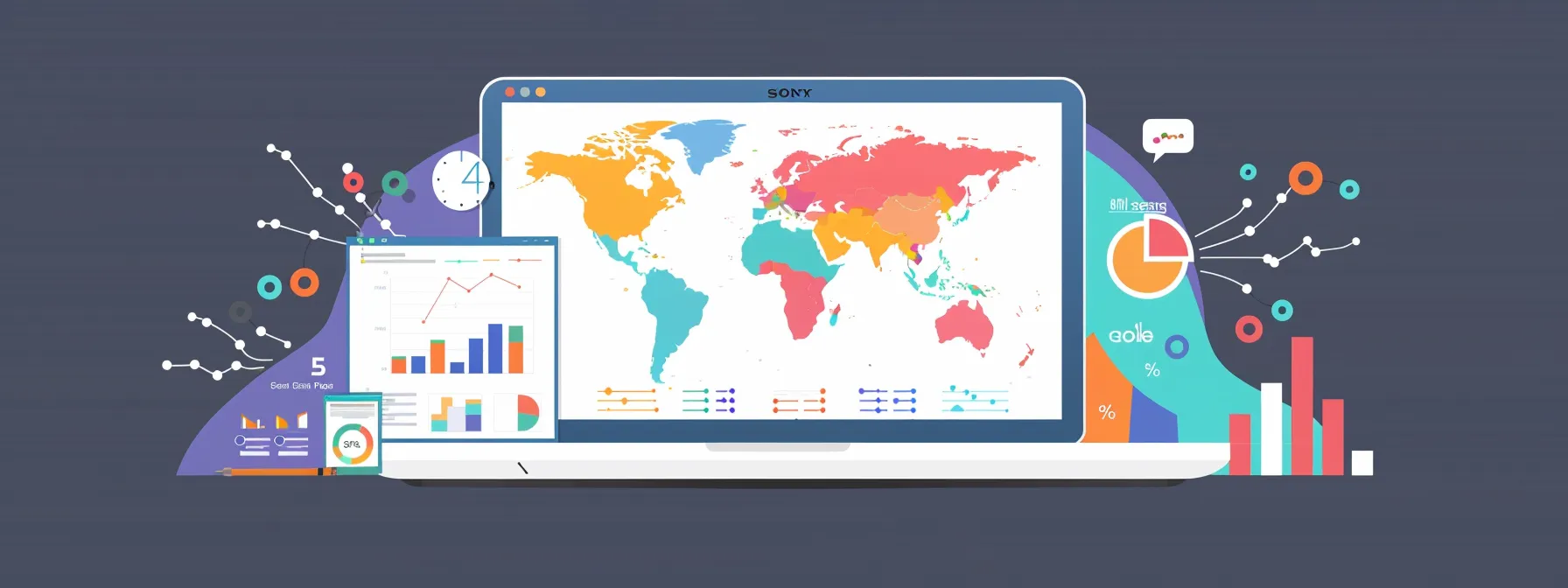Optimizing Your Website With Google Analytics: A Guide for Web Design Professionals
Are you struggling to make data-driven decisions for your website design? Google Analytics is a powerful tool that can revolutionize your approach to web design. This guide will walk you through setting up Google Analytics, navigating essential reports, and implementing data-driven improvements. You’ll learn how to enhance user experience using insights from Google Analytics, integrating principles of gestalt psychology and digital marketing strategies. By the end, you’ll be equipped to optimize your website’s performance and boost your digital marketing efforts, including doubleclick ads, for improved user experience and better results.
Key Takeaways
- Google Analytics provides valuable insights for optimizing website design and user experience
- Customizing dashboards and segmenting data allows for deeper analysis of user behavior
- Integrating Analytics with other tools enhances comprehensive data gathering and analysis
- Regular updates and continuous learning are crucial for leveraging advanced Analytics features
- A/B testing and data-driven design improvements help refine website performance and conversions
Introduction to Google Analytics for Web Design Professionals

As a web design professional, you can leverage Google Analytics to optimize websites effectively. This powerful tool provides insights into user behavior, search engine performance, and site metrics through its intuitive dashboard. You’ll learn key concepts, terminology, and how to use features like drag and drop for data analysis and creating animations to visualize trends.
Understanding the Role of Analytics in Web Design
Analytics plays a crucial role in web design by enabling you to make data-driven decisions. You can use tools like Google Analytics to gather insights about user behavior, which informs your web application design choices. This data helps you understand how visitors interact with your site’s graphics and content, allowing you to optimize the user experience.
By leveraging analytics, you can identify areas of your website that need improvement. For example, you might discover that certain pages have high bounce rates or low engagement. This information enables you to make targeted adjustments to your web design, such as improving page load times or refining your advertising strategies to better resonate with your audience.
Analytics also provides valuable insights into the effectiveness of different design elements and features. You can use A/B testing to compare various layouts, color schemes, or call-to-action buttons. This data-driven approach helps you create a more engaging and user-friendly website, ultimately leading to improved conversions and business outcomes:
Benefits of Using Google Analytics for Website Optimization
Google Analytics offers invaluable insights for optimizing your website. You can track user behavior on dynamic web pages, helping you understand how visitors interact with your content and design elements. This data enables you to make informed decisions about layout, navigation, and typeface choices to enhance user experience and boost engagement.
By leveraging Google Analytics, you can identify which pages capture the most attention and which ones have high bounce rates. This information allows you to focus your optimization efforts on areas that need improvement, potentially leading to increased revenue. You can also track the performance of different design elements and make data-driven decisions to refine your website’s overall aesthetic and functionality.
Google Analytics provides powerful tools for measuring the impact of your design changes. You can set up goals and conversion tracking to see how modifications to your website affect user behavior and business outcomes. This data-driven approach helps you continuously improve your web design, ensuring that your website remains effective and aligned with your business objectives.
Familiarizing Yourself With the Google Analytics Interface
When you first access Google Analytics, you’ll encounter a user-friendly interface designed to enhance your user experience. The dashboard presents key metrics and visualizations, allowing you to quickly grasp essential information about your website’s performance. You’ll find navigation menus on the left side, providing access to various reports and tools for in-depth analysis.
As you explore the interface, you’ll discover multimedia elements that make data interpretation more intuitive. Interactive charts and graphs enable you to visualize trends and patterns in your website’s traffic and user behavior. These visual aids support your research efforts, helping you uncover valuable insights that can inform your web design decisions.
Google Analytics organizes information into several main sections, including Audience, Acquisition, Behavior, and Conversions. Each section offers detailed reports that you can customize to focus on specific metrics relevant to your web design goals. By familiarizing yourself with these sections and their corresponding HTML reports, you’ll be better equipped to extract meaningful data and apply it to your design process.
Key Concepts and Terminology
As a web designer, understanding key Google Analytics concepts is crucial for optimizing websites. Measurement, the cornerstone of analytics, involves collecting and analyzing data about user interactions with your site. Universal Analytics, Google’s previous analytics platform, offers powerful tools for tracking customer experience across various devices and platforms.
Familiarize yourself with essential metrics such as sessions, pageviews, and bounce rate. These metrics provide insights into user behavior and help you assess the effectiveness of your web design. By leveraging this data, you can make informed decisions to enhance user engagement and improve overall site performance.
Google Analytics offers various features to support web designers in their optimization efforts. Custom reports, segments, and goals allow you to tailor your analysis to specific business objectives. Understanding these concepts enables you to extract meaningful insights and apply them to your web design process, ultimately creating a better user experience:
- Sessions: A group of user interactions within a given time frame
- Pageviews: The total number of pages viewed on your site
- Bounce Rate: The percentage of single-page sessions
- Conversion Rate: The percentage of users who complete a desired action
- Segments: Subsets of your data for more focused analysis
The basics of Google Analytics now clear, it’s time to put theory into practice. Let’s set up your website for tracking and unlock its full potential.
Setting Up Google Analytics on Your Website

Setting up Google Analytics on your website is crucial for optimizing your web design and brand strategy. This section covers creating your account, installing the tracking code, configuring settings, and defining goals. By leveraging media queries and understanding user behavior, you can enhance your site’s performance across various devices and improve your internet presence.
Creating Your Google Analytics Account
To create your Google Analytics account, visit the Google Analytics website and sign in with your Google account. Once logged in, you’ll set up a new property for your website, which will generate a unique tracking ID. This process is essential for gathering insights about your web design’s performance and user behavior.
During setup, you’ll configure basic settings like your website’s URL and industry category. These details help Google Analytics provide more relevant data and benchmarks. Consider using web design tools or browser extensions to streamline the setup process and ensure accurate tracking across your site’s hierarchy.
After creating your account, you’ll receive a tracking code to insert into your website’s HTML. Proper placement of this code is crucial for collecting accurate data about your site’s font usage, layout, and overall design effectiveness. Here’s a breakdown of the key steps in creating your Google Analytics account:
Installing the Tracking Code on Your Site
To install the Google Analytics tracking code on your site, access your website’s HTML and locate the tag. Insert the provided tracking code just before the closing tag. This placement ensures that the web beacon captures user interface interactions accurately, enabling you to analyze your site’s performance effectively.
When working with a web development company, communicate the importance of proper tracking code implementation. Ensure they place the code on every page of your website to collect comprehensive data. This approach allows you to measure the effectiveness of your design choices and optimize your site’s user experience within your budget constraints.
After installing the tracking code, verify its functionality using Google Analytics’ real-time reports. This step confirms that data is being collected correctly and allows you to start gathering insights immediately. By leveraging these analytics, you can make informed decisions about your web design, balancing creativity with data-driven improvements to enhance your site’s performance.
Configuring Basic Settings for Accurate Data
To ensure accurate data collection in Google Analytics, configure your basic settings carefully. As a web developer, you’ll need to set up filters to exclude internal traffic and define your site’s default URL. These steps are crucial for obtaining clean, reliable data that informs your responsive web design decisions.
Implement custom dimensions and metrics to track specific elements of your website that are important for your business. This feature allows you to gather more detailed analytics on user behavior, enabling you to refine your search engine optimization strategies. You can use the Google Analytics API to integrate this data with other tools in your web development workflow.
Set up cross-domain tracking if your website spans multiple domains or subdomains. This configuration ensures that you can accurately track user journeys across your entire web presence, providing valuable insights for improving your site’s overall user experience and performance.
Defining Goals and Conversion Tracking
When setting up Google Analytics, defining goals and conversion tracking is crucial for measuring your website’s success. You can create goals to track specific user actions, such as form submissions or product purchases, which align with your business objectives. By incorporating accessibility features into your goal-setting process, you ensure that your website caters to all users, potentially increasing conversions.
Utilize Google Analytics’ goal-setting features to track user interactions with your graphic design elements. You can set up event tracking to monitor clicks on specific buttons or engagement with interactive infographics. This data helps you refine your website’s aesthetics and improve user experience, ultimately leading to higher conversion rates.
Configure conversion tracking to measure the effectiveness of your website’s infrastructure in driving desired actions. By setting up pixel-based tracking, you can gather detailed information about user behavior and optimize your site’s performance. This approach allows you to make data-driven decisions about your web design, balancing visual appeal with functionality to achieve your business goals.
You’ve set up Google Analytics. Now it’s time to put it to work. Let’s explore the essential reports that will shape your design decisions.
Navigating Essential Reports for Web Designers

Navigate essential Google Analytics reports to optimize your website’s build and visual hierarchy. Explore audience demographics, acquisition channels, behavior flow, and content performance to refine your navigation and communication design. Monitor site speed and assess mobile vs. desktop user experience to enhance your web pages’ effectiveness. These insights will guide your design decisions and improve overall site performance.
Analyzing Audience Overview and Demographics
The Audience Overview report in Google Analytics provides valuable insights into your website’s visitors, helping you tailor your web design to their preferences. You can analyze demographics, interests, and behavior patterns to inform your graphic design website decisions. This data enables you to create a more targeted and effective user experience across various mobile devices.
Examine the Demographics report to understand your audience’s age and gender distribution. This information can guide your choice of colors, fonts, and imagery in your web design, ensuring your site appeals to your target demographic. For instance, if your audience skews younger, you might incorporate more dynamic and interactive elements into your art and design.
Leverage the Technology report to gain insights into the devices and browsers your audience uses. This data is crucial for optimizing your website’s performance and ensuring compatibility across different platforms. By understanding your users’ preferred devices, you can refine your programming language choices and responsive design strategies to deliver a seamless experience:
- Analyze user demographics to inform design choices
- Examine technology preferences for better compatibility
- Tailor content and visuals to match audience interests
- Optimize for popular devices and screen sizes
- Adjust your design strategy based on user behavior patterns
Exploring Acquisition Channels
As a web designer, exploring acquisition channels in Google Analytics provides valuable insights into how users find your website. By analyzing this data, you can optimize your landing pages and style sheets to better cater to different traffic sources. Understanding which channels drive the most engagement allows you to refine your color scheme and overall design strategy to improve user experience and conversion rates.
Pay close attention to the performance of organic search traffic, as it often indicates the effectiveness of your SEO efforts. Use this information to adjust your website’s content and structure, ensuring it aligns with user search intent. Consider collaborating with your team during brainstorming sessions to develop design solutions that enhance your site’s visibility and appeal across various acquisition channels.
Examine the behavior of users from different acquisition channels to identify patterns and preferences. This analysis can inform your decisions on layout, navigation, and visual elements, helping you create a more tailored experience for each traffic source. By leveraging these insights, you can continuously refine your web design to maximize engagement and conversions across all acquisition channels.
Interpreting Behavior Flow and Content Performance
Interpreting behavior flow and content performance in Google Analytics provides valuable insights for optimizing your website’s architecture. By analyzing how customers navigate through your site, you can identify popular paths and potential roadblocks, allowing you to refine your design and improve user experience. This tool helps you understand which pages engage users most effectively, guiding your decisions on content placement and overall site structure.
Examine the content performance reports to assess the readability and effectiveness of your web pages. These insights enable you to identify which pages drive the most engagement and conversions, helping you replicate successful elements across your site. Use this data to inform your content strategy and design choices, ensuring your website delivers value to users while supporting your business goals.
While Google Analytics is a powerful tool, consider complementing it with best website builders that offer built-in analytics features. These platforms often provide user-friendly interfaces and additional metrics specific to web design, enhancing your ability to create and optimize high-performing websites. By combining insights from multiple sources, you can develop a comprehensive understanding of your site’s performance and make data-driven improvements to its design and functionality.
Monitoring Site Speed and Performance Metrics
Monitor your website’s speed and performance metrics using Google Analytics to ensure optimal user experience. Your content management system plays a crucial role in site speed, so regularly analyze load times and identify areas for improvement. Pay attention to server response times and image optimization to enhance overall performance.
Use web analytics tools to track key performance indicators such as page load time, bounce rate, and time on page. These metrics provide valuable insights into how your site’s speed affects user behavior. Consider implementing typography optimizations and minimizing HTTP requests to improve load times across different devices and browsers.
Leverage Google Analytics’ Site Speed report to identify slow-loading pages and prioritize improvements. This data-driven approach allows you to make informed decisions about optimizing your website’s performance. By addressing speed issues, you can enhance user satisfaction, improve search engine rankings, and ultimately drive better results for your digital agency clients.
Assessing Mobile vs. Desktop User Experience
Assess the differences between mobile and desktop user experiences using Google Analytics’ device segmentation reports. These reports provide valuable customer insights, allowing you to tailor your web design for optimal performance across all devices. By analyzing pageviews and engagement metrics for each device type, you can identify areas where your mobile or desktop experience may need improvement.
Use the WYSIWYG editing features in your content management system to make responsive design adjustments based on Google Analytics data. Focus on creating a seamless experience for your target audience, regardless of the device they use. Pay attention to metrics such as bounce rate and time on page to gauge the effectiveness of your mobile and desktop layouts.
Leverage Google Analytics’ behavior flow reports to understand how users navigate your site on different devices. This information helps you optimize your site’s structure and content placement for both mobile and desktop users. By continually refining your design based on these insights, you can ensure your website meets the needs of your entire target audience, regardless of their preferred device.
Data tells stories. The web designer who listens becomes a better creator.
Enhancing User Experience Through Data Analysis

Enhance user experience by leveraging Google Analytics data. Identify high exit and bounce rate pages, understand user navigation patterns, and optimize landing pages. Utilize heatmaps and click tracking to refine your website design. As a website design company, use these insights to improve your HTML elements, color choices, and website wireframes. Incorporate BigQuery for advanced data analysis to drive informed design decisions.
Identifying High Exit and Bounce Rate Pages
Identifying high exit and bounce rate pages through data analysis is crucial for improving your website’s performance. Use Google Analytics to pinpoint pages where users frequently leave your site or bounce without interaction. This insight allows you to focus your optimization efforts on problematic areas, potentially increasing your return on investment in web development.
Examine the page layout of high-exit pages to identify potential issues that may be causing users to leave. Consider factors such as content relevance, navigation clarity, and call-to-action placement. By addressing these elements, you can create a more engaging interactive design that encourages users to explore further.
Leverage Google Developers tools in conjunction with Analytics to gain deeper insights into page performance. Analyze load times, mobile responsiveness, and user behavior flow to identify technical issues that may contribute to high bounce rates. Use this data to refine your website’s structure and functionality, creating a seamless user experience across all devices:
Understanding User Navigation Patterns
As a website development company, understanding user navigation patterns is crucial for optimizing your site’s structure and user experience. Google Analytics provides valuable data collection tools to help you analyze how visitors interact with your website. By examining behavior flow reports, you can identify common paths users take through your site and optimize these journeys to improve engagement and conversions.
Use Google Analytics to gather statistics on popular landing pages and exit points. This data helps you understand where users enter your site and where they tend to leave. By analyzing these patterns, you can refine your site’s architecture and improve navigation to guide users toward your desired actions or key messages more effectively.
Pay close attention to the behavior of different user segments, such as new visitors versus returning users. This insight allows you to tailor your website’s navigation and content to meet the specific needs of each group. By continuously analyzing and adapting to user navigation patterns, you can create a more intuitive and user-friendly website that encourages longer visits and higher conversion rates.
Optimizing Landing Pages Based on Insights
Optimize your landing pages using insights from Google Analytics to improve user experience and conversion rates. Analyze metrics such as bounce rate, time on page, and conversion rate to identify areas for improvement. Use this data to refine your website builders’ templates or custom designs, ensuring they align with user expectations and behavior patterns.
Leverage Google Analytics to understand how different web browsers and devices affect landing page performance. This information can help you optimize your bootstrap-based designs for better cross-platform compatibility. Pay attention to metrics like page load time and mobile responsiveness to create landing pages that perform well across various devices and browsers.
Use Google Analytics’ IP address tracking capabilities to gain insights into your audience’s geographic location and tailor your landing pages accordingly. This data can inform your content strategy, helping you create more relevant and engaging landing pages for specific user segments. Consider A/B testing different landing page elements to continuously refine and improve your designs based on analytics data:
- Analyze key metrics to identify improvement areas
- Optimize for different browsers and devices
- Tailor content based on geographic insights
- Conduct A/B tests to refine landing page elements
- Continuously iterate based on analytics data
Utilizing Heatmaps and Click Tracking
Utilize heatmaps and click tracking in Google Analytics to gain deeper insights into user behavior on your website. These tools provide visual representations of where users click, scroll, and spend time on your pages. By integrating javascript with the Google Marketing Platform, you can collect valuable customer data to inform your web design decisions and optimize user experience.
Analyze heatmaps to identify which elements of your web pages attract the most attention and engagement. This information can guide your design choices in tools like Figma, helping you prioritize important content and optimize call-to-action placement. Pay close attention to areas of high and low engagement to refine your layout and improve overall user interaction.
Implement click tracking to understand how users navigate through your site and interact with specific elements. This data can help you optimize your URL structure and improve internal linking strategies. By combining click tracking insights with other Google Analytics metrics, you can create a more comprehensive picture of user behavior and make data-driven design decisions:
- Identify high-engagement areas on your pages
- Optimize call-to-action placement
- Refine navigation based on user click patterns
- Improve content layout and prioritization
- Enhance overall user experience through data-driven design
The data spoke. We listened and learned. Now, it was time to act on our newfound knowledge.
Implementing Data-Driven Design Improvements

Implement data-driven design improvements to optimize your website’s interface and mobile app performance. Prioritize enhancements based on analytics data, conduct A/B testing for design changes, measure redesign impact, and leverage user feedback. Use these insights to refine your website builder strategy and create a more effective digital space for your audience.
Prioritizing Site Enhancements Based on Data
As website developers near you, prioritizing site enhancements based on Google Analytics data is crucial for effective web development. You can identify areas that need improvement by analyzing user behavior, conversion rates, and engagement metrics. This data-driven approach helps you focus your efforts on changes that will have the most significant impact on your site’s performance.
Understanding your website’s workflow is essential for making informed decisions about improvements. Use Google Analytics to track user journeys and identify bottlenecks or pain points in your site’s navigation. By addressing these issues, you can create a smoother user experience and potentially increase conversions.
Consider incorporating Webflow into your development process to streamline your site enhancements. This powerful tool allows you to implement changes quickly based on your analytics insights. By combining Google Analytics data with Webflow’s capabilities, you can create a more efficient and effective web development process:
- Analyze user behavior and engagement metrics
- Identify bottlenecks in site navigation
- Implement changes using Webflow
- Monitor the impact of enhancements
- Continuously refine your website based on data
Testing Design Changes Using a/B Testing
A/B testing is a powerful marketing tool that allows you to refine your web design based on data-driven insights. By creating two versions of a webpage and comparing their performance, you can make informed decisions about which design elements are most effective. This fluid approach to optimization helps you continually improve your website’s user experience and conversion rates.
To conduct successful A/B tests, start by identifying key areas of your website that could benefit from optimization. Use your database of user behavior data from Google Analytics to guide your test hypotheses. Focus on elements that have a significant impact on user experience, such as call-to-action buttons, page layouts, or content structure.
As you implement A/B tests, remember that the skill lies in interpreting the results accurately. Analyze the data carefully to understand which version performs better and why. Use these insights to inform future design decisions and continuously refine your website. By embracing a culture of constant testing and improvement, you’ll develop a website that truly resonates with your target audience.
Measuring the Impact of Redesigns
When measuring the impact of website redesigns, Google Analytics data becomes your most valuable tool. By comparing key metrics before and after the redesign, you can quantify improvements in user engagement and conversions. Focus on metrics such as bounce rate, time on site, and goal completions to assess the effectiveness of your new design.
As you evaluate the redesign’s impact, pay close attention to how users interact with your new CSS and layout. Use Google Analytics’ behavior flow reports to identify any changes in navigation patterns or potential pain points. This insight allows you to fine-tune your website design concept, ensuring it aligns with user expectations and business goals.
To gain a comprehensive understanding of your redesign’s impact, combine quantitative data from Google Analytics with qualitative user feedback. Conduct surveys or usability tests to gather insights on the new design’s aesthetics and functionality. This holistic approach helps you make informed decisions about further optimizations, ensuring your website continues to meet both user needs and business objectives.
Leveraging User Feedback and Behavior Data
Leverage user feedback and behavior data from Google Analytics to enhance your website’s interactivity and design. By analyzing user interactions with your prototype, you can identify areas where technology can improve the user experience. This data-driven approach allows you to refine your design based on real-world usage patterns, ensuring your website meets user needs effectively.
Use Google Analytics to track how users navigate through your site’s world wide web presence. This information helps you optimize your site’s structure and content hierarchy, making it easier for visitors to find what they’re looking for. By understanding user behavior, you can create more intuitive navigation and improve the overall user experience on your website.
Combine quantitative data from Google Analytics with qualitative user feedback to gain a comprehensive understanding of your website’s performance. Use surveys or user testing sessions to gather insights on specific design elements or features. This holistic approach allows you to make informed decisions about your website’s design and functionality, ensuring it aligns with both user preferences and business objectives.
The data spoke. We listened. Now, let’s dive deeper into Google Analytics to uncover hidden treasures.
Advanced Strategies With Google Analytics

As website creators, you can leverage advanced Google Analytics strategies to enhance your web design process. Learn to customize dashboards for quick insights, segment data for deeper analysis, and integrate Analytics with other tools. Explore how machine learning impacts user behavior tracking and stay updated on best practices. These techniques will help you create more effective, user-friendly websites with improved usability and logo placement.
Customizing Dashboards for Quick Insights
As a website designer near me, you can leverage Google Analytics’ customizable dashboards to gain quick insights into your site’s performance. By creating tailored dashboards, you can easily monitor key metrics that matter most to your user interface design. This approach allows you to quickly identify trends and make data-driven decisions to improve your website’s effectiveness.
When customizing your dashboard, consider including widgets that track personal data in compliance with the General Data Protection Regulation (GDPR). This ensures you’re monitoring user behavior while respecting privacy regulations. Focus on metrics that directly impact your design decisions, such as bounce rates, session duration, and conversion rates, to create a more user-centric website.
To maximize the value of your custom dashboards, regularly review and update them based on your evolving design goals and user needs. Use the data collected to inform your design iterations and A/B testing strategies. By continuously refining your dashboards, you’ll maintain a clear overview of your website’s performance and identify opportunities for improvement in real-time.
Segmenting Data for Deeper Analysis
When building your website, segmenting data in Google Analytics allows you to gain deeper insights into user behavior. By creating custom segments based on factors like device type, location, or user actions, you can uncover patterns that inform your HTML5 and PHP development decisions. This granular approach helps you tailor your markup language and icon placements to specific user groups, enhancing overall site performance.
Leverage segmentation to analyze how different user groups interact with your website’s features. For example, you might discover that mobile users have higher bounce rates on certain pages, indicating a need for responsive design improvements. By segmenting data, you can identify these issues and optimize your build website process to create a more seamless experience across all devices.
Use Google Analytics’ advanced segmentation features to compare the performance of different user groups side by side. This allows you to identify which segments are most valuable to your business and tailor your website design accordingly. By focusing on high-performing segments, you can prioritize design elements and functionality that resonate with your most engaged users:
Integrating Google Analytics With Other Tools
Integrating Google Analytics with other tools enhances your ability to gather and analyze comprehensive data about your website’s performance. You can connect Google Analytics with tools like Google Tag Manager to streamline your tracking setup and manage multiple tags efficiently. This integration allows you to implement complex tracking scenarios without modifying your website’s code directly.
By integrating Google Analytics with your content management system (CMS), you can gain deeper insights into how your content performs. This connection enables you to track specific content elements and user interactions more accurately, helping you make data-driven decisions about your content strategy. You can use this information to optimize your website’s layout, content placement, and overall user experience.
Consider integrating Google Analytics with your customer relationship management (CRM) system to create a more holistic view of your user journey. This integration allows you to track user interactions from initial website visit through to conversion and beyond, providing valuable insights for both your web design and marketing efforts. By leveraging these combined data sources, you can create more personalized and effective user experiences:
- Connect Google Analytics with Google Tag Manager
- Integrate with your CMS for content performance insights
- Link to your CRM for comprehensive user journey tracking
- Use combined data to optimize web design and marketing strategies
- Implement advanced tracking scenarios without code modifications
Keeping Up With Updates and Best Practices
Stay updated with Google Analytics’ latest features and best practices to maximize your website’s performance. Regularly check the official Google Analytics blog and documentation for announcements about new tools, metrics, and reporting capabilities. By keeping abreast of these updates, you can leverage the most advanced features to refine your web design and improve user experience.
Engage with the web design community through forums, webinars, and conferences to learn from others’ experiences with Google Analytics. Share your insights and challenges, and discover innovative ways to apply analytics data to your design process. This collaborative approach will help you stay ahead of industry trends and implement cutting-edge strategies in your projects.
Invest time in continuous learning by taking Google Analytics certification courses and participating in workshops. These educational resources will deepen your understanding of advanced analytics techniques and help you interpret complex data more effectively. By staying committed to ongoing education, you’ll be better equipped to make data-driven decisions that enhance your website’s performance and user engagement.


